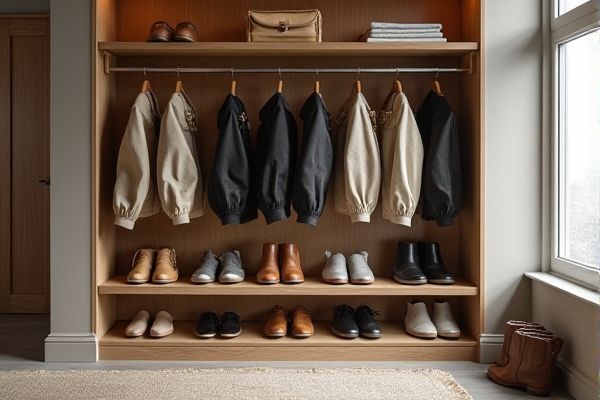
A boot cabinet offers enclosed storage that protects your footwear from dust and keeps your boots upright, ideal for maintaining their shape and prolonging their life, whereas a shoe rack provides open, accessible shelving that allows quick selection and ventilation for everyday shoes. Discover which option suits Your space and lifestyle best by exploring the detailed comparison in the rest of this article.
Table of Comparison
| Feature | Boot Cabinet | Shoe Rack |
|---|---|---|
| Purpose | Stores and protects boots | Organizes various types of shoes |
| Design | Enclosed cabinet with doors | Open shelves or tiers |
| Space Efficiency | Compact with vertical storage | Varies; can be stacked or wall-mounted |
| Protection | Protects from dust, damage | Limited protection, exposes shoes |
| Material | Typically wood or metal | Wood, metal, plastic options |
| Capacity | Holds fewer pairs, focuses on boots | Higher capacity for all shoe types |
| Aesthetic | Formal and neat appearance | Casual, accessible display |
| Cost | Generally more expensive | Usually more affordable |
Introduction to Boot Cabinets and Shoe Racks
Boot cabinets and shoe racks serve distinct storage purposes by organizing footwear efficiently while enhancing space utilization. Boot cabinets feature enclosed compartments designed to protect boots from dust and maintain their shape, making them suitable for larger, taller footwear. Shoe racks offer open shelving ideal for everyday shoes, promoting ventilation and quick access, which is beneficial in compact spaces or entryways.
Key Differences Between Boot Cabinets and Shoe Racks
Boot cabinets offer enclosed storage with doors, providing protection from dust and a tidier appearance, while shoe racks typically feature open shelves for easy access and ventilation. Boot cabinets are often designed to accommodate taller footwear such as boots, whereas shoe racks are suited for various shoe types but may lack the height to store bulky boots effectively. Material and design variations also differentiate them; boot cabinets usually have a more robust build for durability, whereas shoe racks prioritize simplicity and flexibility in placement.
Design and Construction Comparison
Boot cabinets feature enclosed storage with solid doors and sturdy frames, offering protection from dust and moisture while maintaining a sleek appearance. Shoe racks typically have open shelving made from metal or wood, promoting ventilation and easy access but exposing footwear to environmental elements. The robust build of boot cabinets often includes adjustable shelves for different boot heights, whereas shoe racks provide simpler, more flexible arrangements for various shoe types.
Storage Capacity and Space Efficiency
Boot cabinets offer higher storage capacity with enclosed compartments that protect footwear from dust and provide organized vertical space, making them ideal for maximizing storage in smaller entryways. Shoe racks typically have open shelves that allow quick access and air circulation but hold fewer pairs in the same footprint compared to boot cabinets. Your choice depends on whether you prioritize compact, concealed storage or ease of access and airflow for your shoes.
Material Options and Durability
Boot cabinets typically offer a wider range of material options including solid wood, metal, and engineered wood, providing enhanced durability and resistance to wear and moisture. Shoe racks are often made from plastic, metal, or lightweight wood, which may result in less robustness and shorter lifespan under heavy use. Choosing a boot cabinet ensures longevity and stronger construction, ideal for protecting heavier or bulkier footwear.
Aesthetic Appeal and Home Décor Integration
Boot cabinets offer a sleek, enclosed design that enhances your home decor by concealing footwear and reducing visual clutter, making them ideal for maintaining a minimalist aesthetic. Shoe racks, often open and functional, provide easy access and can complement casual or rustic interiors but may appear less refined in modern or upscale settings. Choosing between a boot cabinet and a shoe rack depends on your preference for either polished elegance or straightforward practicality in your entryway.
Ease of Access and Organization
Boot cabinets offer enclosed storage with compartments or shelves that protect footwear from dust while keeping your boots upright and easy to retrieve. Shoe racks provide open, tiered storage allowing quick visibility and immediate access to your shoes, making it easier to grab your daily pairs. Your choice depends on whether you prioritize organized concealment or rapid accessibility for your footwear.
Maintenance and Cleaning Requirements
Boot cabinets typically require less frequent cleaning due to their enclosed design, which protects footwear from dust and dirt, while shoe racks demand regular dusting as shoes are exposed. Maintaining a boot cabinet involves occasional wiping with a damp cloth and ensuring ventilation to prevent odor buildup, whereas shoe racks often need more frequent cleaning, especially if placed in high-traffic areas prone to mud and debris. The material of both storage options impacts cleaning ease; for example, wooden or laminated boot cabinets resist stains better than metal shoe racks, which might show rust or corrosion without proper upkeep.
Price Range and Value for Money
Boot cabinets generally cost between $150 and $600, offering enclosed storage that protects footwear from dust and enhances room aesthetics, providing greater value for those seeking organized and tidy spaces. Shoe racks typically range from $20 to $150, making them a budget-friendly option favored for easy access and ventilation but often lacking the protective benefits of boot cabinets. Choosing between the two depends on balancing budget constraints with desired storage features, where boot cabinets justify higher prices with durability and design, while shoe racks maximize affordability and convenience.
Choosing the Right Option for Your Needs
A boot cabinet offers enclosed storage that protects footwear from dust and maintains a tidy appearance, making it ideal for those seeking organization and aesthetics in entryway spaces. In contrast, a shoe rack provides open, easy-access storage suitable for frequently worn shoes, prioritizing convenience over concealment. Selecting the right option depends on available space, desired level of organization, and personal preferences for shoe care and accessibility.
 homyna.com
homyna.com